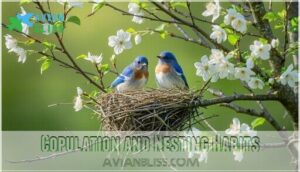This site is supported by our readers. We may earn a commission, at no cost to you, if you purchase through links.

Species like swans, bald eagles, albatrosses, and Atlantic puffins demonstrate remarkable fidelity, often staying together through multiple breeding seasons.
These monogamous birds don’t just share nesting duties—they coordinate migration routes, defend territories together, and perform annual courtship rituals to strengthen their bond.
When one partner dies, many birds will mourn for extended periods, sometimes remaining single for years or even the rest of their lives.
This devotion isn’t just romantic; it’s an evolutionary advantage that improves breeding success and chick survival rates.
The intricate behaviors and surprising emotional depth of these avian partnerships reveal fascinating secrets about nature’s most committed couples.
Table Of Contents
- Key Takeaways
- Birds Mating for Life
- Monogamous Bird Characteristics
- Bird Pair Formation
- Birds Grieving Lost Mates
- Long-Term Bird Bonds
- Unique Bird Mating Habits
- Conservation of Monogamous Birds
- Frequently Asked Questions (FAQs)
- What birds mate for life?
- Which animals mate for life?
- What percentage of birds mate with a single partner?
- Why do birds mate for life?
- Do birds cheat if they mate for life?
- Can a bird mate if its partner dies?
- What birds mate for a lifetime?
- What do birds do when their mate dies?
- Which bird is most loyal to their partner?
- What is a monogamous bird?
- Conclusion
Key Takeaways
- You’ll discover that monogamous birds like swans, eagles, and albatrosses form incredibly strong partnerships lasting decades, with some species showing fidelity rates as high as 95% despite genetic studies revealing extra-pair paternity in 20-30% of offspring.
- You’ll find these devoted pairs share essential survival advantages including cooperative territory defense, synchronized parenting duties, and improved chick survival rates that make lifelong partnerships an evolutionary winning strategy.
- You’ll observe touching mourning behaviors when partners die, as widowed birds often remain solitary for extended periods, calling for missing mates and showing depression-like symptoms before eventually seeking new companions.
- You’ll need to support conservation efforts protecting these species since habitat loss, climate change, and human interference threaten their delicate pair bonds and specialized breeding territories essential for maintaining stable partnerships.
Birds Mating for Life
You’ll discover that many birds form remarkably strong partnerships that last their entire lives, with some species showing fidelity rates as high as 95%.
These devoted avian couples demonstrate complex bonding behaviors that extend far beyond simple reproduction, creating lasting relationships that rival the strongest human partnerships, showcasing remarkably strong bonds.
Eastern Bluebird Mating Dynamics
Eastern Bluebirds showcase fascinating mating dynamics that challenge simple notions of avian fidelity.
While 95% mate for life, genetic studies reveal 20-30% of nestlings result from extra-pair paternity.
Winter pair-formation occurs during migration, with copulation initiation triggered by female solicitation postures.
Divorce causes include repeated nest failures, though communal breeding occasionally involves multiple partners assisting with chick-rearing duties.
They’re known to nest in natural tree cavities, or even nest boxes, which is an interesting aspect of their avian fidelity and communal breeding habits.
Genetic Studies on Bird Monogamy
DNA fingerprinting reveals shocking truths about monogamous birds—you’d be surprised to learn that 90% of supposedly faithful species actually engage in extra-pair paternity.
Genetic monogamy proves rare, with only 19% of offspring truly sired by social partners.
These evolutionary drivers challenge everything we thought we knew about avian fidelity and bird mating systems.
Scientists have found a common genetic signature across monogamous species, which helps us understand the genetic roots of their behavior.
Examples of Monogamous Bird Species
You’ll discover that monogamous birds create some of nature’s most touching partnerships.
These lifelong pairs demonstrate remarkable dedication through shared responsibilities and consistent bonding behaviors.
- Cardinals maintain year-round territories with their mates, showing true cardinal monogamy
- Albatrosses reunite annually despite their impressive albatross lifespan of 50+ years
- Puffins perform charming puffin billing ceremonies to reconnect after winter separations
- Condors develop deep condor bonding through shared cliff-nesting and soaring together
Monogamous Bird Characteristics
You’ll notice that monogamous birds share specific traits that make lifelong partnerships successful, including strong territorial instincts and cooperative parenting behaviors.
These characteristics have evolved because monogamy offers clear survival advantages, though environmental pressures can influence whether birds maintain their pair bonds, which is a key factor in their monogamy.
Traits of Monogamous Birds
Monogamous birds share distinctive characteristics that set them apart from their more promiscuous counterparts.
You’ll find these devoted species exhibit remarkable pair bond strength, with some maintaining relationships spanning decades.
Their mate selection process involves careful evaluation of potential partners’ quality and compatibility.
| Trait | Description |
|---|---|
| Territory defense | Partners jointly protect nesting areas |
| Cooperative breeding | Both parents share chick-rearing duties |
| Low divorce rates | Most pairs remain together across seasons |
| Mate for life commitment | Strong bird bonding creates lifelong pairs |
These monogamous birds demonstrate exceptional bird commitment through synchronized behaviors and shared responsibilities that strengthen their lifelong pairs.
Benefits of Monogamy in Birds
You’ll find that monogamous birds reap significant advantages from their lifelong partnerships. Shared parental care doubles the workforce, while cooperative breeding creates stronger family units. These dedicated pairs achieve increased offspring survival rates through combined efforts in nest protection and food gathering.
However, even without a mate, hormonal imbalances can trigger egg laying.
- Enhanced territory defense – Two birds patrolling boundaries together deter predators and competitors more effectively than solo defenders
- Reduced energy expenditure – Partners split demanding tasks like incubation, feeding, and nest maintenance throughout breeding seasons
- Improved chick survival – Dual parental investment means constant protection, regular feeding schedules, and better developmental outcomes for young
- Strategic resource sharing – Monogamous pairs coordinate foraging efforts, reducing competition while maximizing food collection efficiency
- Long-term reproductive success – Established partnerships eliminate yearly mate-searching costs, allowing more energy for actual bird reproduction activities
Environmental Factors Affecting Monogamy
Throughout the year, environmental pressures shape whether monogamous birds stay faithful to their partners.
Habitat Loss fragments breeding grounds, forcing birds into smaller territories where mate switching becomes more common. Climate Change disrupts timing patterns, while Resource Availability determines pair bond strength.
| Environmental Factor | Impact on Monogamy | Conservation Response |
|---|---|---|
| Habitat Loss | Increases divorce rates | Protect breeding territories |
| Climate Change | Disrupts pair timing | Monitor weather patterns |
| Pollution Impact | Reduces reproductive success | Clean habitat restoration |
| Human Disturbance | Breaks established bonds | Create buffer zones |
Bird ecology research shows that stable, high-quality bird habitats support lifelong partnerships, while degraded environments force frequent mate changes among bird population dynamics.
Approximately 90% of bird species display monogamous behavior, influencing population dynamics.
Bird Pair Formation
When you watch birds forming pairs, you’ll notice timing varies dramatically across species and regions.
Pair formation begins as early as mid-January in southern states and extends through March in northern areas, with some species like albatrosses taking up to 10 years to select their lifelong partner.
Timing of Pair Formation
Most monogamous birds time their pair bonding strategically throughout the year.
Over 62% of lifelong couples begin Winter Pairings at least 12 months before breeding, while Migratory Mates often form bonds upon reaching summer grounds.
Latitude Variation affects timing—southern species start in mid-January, northern ones wait until February-March.
Territory Establishment and courtship typically precede Nest Suitability demonstrations, with breeding behavior varying substantially between resident and migratory populations across different bird mating rituals.
Pair Bond Confirmation
Once pairs establish their initial bond, you’ll observe specific behaviors that confirm their commitment.
The pair bond becomes official when both monogamous birds enter a nesting cavity together, with the male demonstration showing nest suitability to his potential mate.
This mutual entry signals their readiness for breeding behavior and strengthens their bird relationships through shared territory acceptance and partnership confirmation.
Displays of affection, such as mutual preening behaviors, also indicate a strong bond.
Copulation and Nesting Habits
Once pairs have bonded, their copulatory behavior becomes highly coordinated. Females initiate copulation through specific postures, signaling readiness for nest formation.
Here’s how these breeding territories function:
- Copulation Initiation occurs when females crouch and shake wings
- Nesting Cavity selection confirms the pair bond strength
- Extra-Pair Paternity affects 20-30% of offspring despite monogamy
- Territory Quality influences breeding success and nest formation
- Breeding Families may include helper birds from previous broods
Bird nesting success depends on coordinated efforts and nest success rates improve with experienced pairs.
Consider providing safe nesting habitats to encourage successful breeding.
Birds Grieving Lost Mates
When you lose a mate that you’ve bonded with for life, the grief can be overwhelming and deeply personal.
Most birds that mate for life experience a distinct mourning period where they’ll remain solitary near familiar territories, calling out for their missing partner and showing signs of distress before eventually seeking a new companion.
Initial Mourning Period
Watching a beloved partner vanish creates profound grief duration that mirrors human mourning experiences.
Widowed birds exhibit solitary behavior immediately after mate loss, displaying depressionlike symptoms through decreased activity and appetite changes.
These mourning rituals include calling repeatedly for absent partners and revisiting shared nesting sites.
Post-loss survival depends on the species’ emotional resilience and available support systems within their community.
Solitude and Re-pairing
After losing their mate, birds experience varying solitude periods before re-pairing.
Some species find new partners within thirty minutes, while others remain alone for years.
Post-Mate Behavior includes increased calling and decreased activity during this period.
The Re-pairing Timeline depends on species, breeding season timing, and available partners.
Monogamy doesn’t prevent future bonds – most birds that mate for life successfully adapt, showing remarkable emotional complexity in their grieving behaviors and eventual recovery.
Exceptions in Some Bird Species
While most birds maintain lifelong partnerships, genetic analysis reveals surprising flexibility in avian behavior.
You’ll discover that even devoted species sometimes engage in partner switching when circumstances demand it.
- Extra-pair copulations occur in 20-30% of nestlings among typically monogamous species
- Divorce reasons include repeated nest failures and territorial quality issues
- Polygamous arrangements emerge when two females share one male’s territory
- Communal breeding happens when young birds assist with subsequent broods
- Multiple sires within single broods demonstrate complex mating strategies
Long-Term Bird Bonds
You’ll witness some of nature’s most remarkable partnerships when you observe birds that form lifelong bonds with their chosen mates.
These devoted couples demonstrate extraordinary commitment through decades of shared nesting, migration, and territory defense that puts human relationships to shame, showcasing their extraordinary commitment.
Snowy Albatross Mating Habits
Snowy albatrosses showcase remarkable courtship rituals that span decades, with pairs reuniting annually after months apart at sea.
These magnificent seabirds demonstrate extraordinary mate for life devotion, with divorce rates below 3%.
Their elaborate courtship involves synchronized dancing, bill-clapping, and aerial displays that strengthen bonds essential for successful chick rearing and territory defense throughout their impressive lifespans.
California Condor Bonding Process
California Condors form incredibly strong pair bonds that can last decades, with some couples staying together for over twenty years.
These magnificent birds reach sexual maturity between ages five and eight, carefully selecting mates through elaborate courtship displays involving synchronized flights and mutual preening.
Once paired, condor couples demonstrate remarkable nesting fidelity and co-parenting roles, sharing incubation duties for nearly two months and jointly raising their single chick for up to two years, making them true examples of bird species mating for life.
Atlantic Puffin Long-Term Monogamy
After winter separation, Atlantic Puffins reunite with remarkable loyalty.
These colorful seabirds demonstrate bird species fidelity through their distinctive rituals and behaviors that strengthen lifelong bird bonds.
When partners reconnect, they engage in three essential bonding activities:
- Billing Behavior – touching beaks in affectionate greeting ceremonies
- Nest Restoration – rebuilding their clifftop burrows together as a team
- Chick Rearing – sharing parental duties throughout the breeding season.
This avian monogamy showcases how Puffin Pair Bonds endure despite months apart, making their bird mating behavior truly extraordinary.
Unique Bird Mating Habits
While most birds form seasonal partnerships, you’ll discover that some species have developed fascinating mating behaviors that set them apart from typical monogamous pairs.
These unique adaptations range from complex communal relationships to specialized courtship rituals that strengthen lifelong bonds.
Finches and Hummingbirds Mating Habits
While both finches and hummingbirds showcase different approaches to bird species relationships, their courtship and mating behaviors reveal fascinating contrasts.
During finch courtship, females solicit food from prospective mates, with males either mock feeding or regurgitating food into the female’s mouth. House finches practice social monogamy only, remaining with partners for consecutive seasons or switching mid-breeding season depending on circumstances.
Hummingbird fidelity differs dramatically – pairs don’t maintain relationships through breeding seasons, with males offering no help after mating. This leads to an increased risk of hybridization when resource availability affects nesting competition between these bird breeding pairs.
Red-winged Blackbirds Communal Relationships
Unlike typical monogamous birds, red-winged blackbirds create fascinating communal relationships through polygynous social structures.
Males defend territories attracting up to 15 females, while bird populations form massive winter flocks reaching one million birds.
The males have distinctive red epaulets used in mating displays.
- Communal nesting occurs in loose colonies where females crowd nests within high-quality male territories
- Cooperative defense emerges as neighboring males help protect each other’s broods despite mixed paternity
- Social hierarchy develops among females based on settlement order and proximity to prime nesting spots
Northern Cardinals Mating Habits
You’ll notice Northern Cardinals mate for life through distinct courtship rituals.
Males establish cardinal territories and perform elaborate displays, feeding potential mates seeds as bonding gestures.
Once pair bonding occurs, these devoted couples share nesting behavior responsibilities.
Both parents provide exceptional parental care, with males often feeding females during incubation.
Their bird social behavior demonstrates true partnership throughout bird breeding cycles, showing exceptional parental care.
Conservation of Monogamous Birds
Protecting monogamous bird species requires urgent conservation efforts as habitat loss and climate change threaten their long-term partnerships.
You’ll find that preserving these devoted pairs isn’t just about saving individual birds, but maintaining the delicate ecological balance that depends on their lifelong commitments to territory defense and cooperative breeding, which is crucial for their long-term partnerships.
Threats to Monogamous Bird Species
Several significant threats put monogamous bird species at risk, jeopardizing their lifelong partnerships.
You’ll find these challenges increasingly impact bird conservation status worldwide.
- Habitat Loss destroys nesting sites and reduces territory availability for pair bonding
- Climate Change disrupts migration patterns and breeding synchronization between mates
- Invasive Species compete for resources and prey on eggs, threatening reproductive success
- Pollution Impact from pesticides weakens immune systems and reduces fertility rates
- Human Interference through development fragments territories and separates established pairs
These bird threats create cascading effects that undermine the delicate balance monogamous species need for successful reproduction and long-term survival.
Conservation Strategies for Monogamous Birds
You can protect monogamous bird species through habitat preservation, which maintains essential breeding territories.
Climate change adaptation helps birds cope with shifting environments, and breeding programs boost genetic diversity while reducing threats like pollution and nest disturbance.
Bird conservation efforts focus on creating protected corridors, and supporting bird habitat initiatives can substantially aid these efforts to enhance bird conservation.
Bird conservation groups monitor population health and implement targeted protection strategies for species facing declining conservation status.
Importance of Preserving Bird Monogamy
Protecting monogamous birds strengthens entire ecosystems through their lifelong partnerships. When bird species conservation succeeds, these devoted pairs maintain genetic diversity across populations.
Habitat preservation supports their complex bonding rituals and nesting requirements. Climate change disrupts migration patterns that monogamous animals depend on for reuniting.
Conservation efforts must prioritize these special relationships because losing one partner often means losing both birds, doubling ecological impacts on vulnerable species. This is crucial as genetic diversity and ecological impacts are significant concerns in the conservation of monogamous bird species.
Frequently Asked Questions (FAQs)
What birds mate for life?
You’ll find swans, eagles, and albatrosses among birds that truly mate for life.
Cardinals, cranes, and many owl species also form lasting bonds, returning to the same partner each breeding season throughout their lives.
Which animals mate for life?
While humans divorce at alarming rates, you’ll find nature’s romantics put us to shame.
Swans, wolves, beavers, albatrosses, and prairie voles choose one partner for life, creating bonds that’d make poets weep with envy.
What percentage of birds mate with a single partner?
Around 90% of bird species practice monogamy, though many aren’t strictly faithful.
You’ll find that while most birds pair up for breeding seasons, extra-pair copulations are common, keeping genetics diverse across populations.
Why do birds mate for life?
Birds mate for life because you’ll find it creates several survival advantages.
When pairs stay together, they’re more efficient at raising offspring, defending territory, and sharing parenting duties throughout multiple breeding seasons.
Do birds cheat if they mate for life?
Yes, you’ll find that "monogamous" birds often cheat. Even Eastern Bluebirds, which mate for life, have 20-30% of nestlings sired by males outside the pair through extra-pair copulations.
Can a bird mate if its partner dies?
When a lifelong mate dies, you’ll find that most "monogamous" birds quickly seek new partners.
They’re pragmatic about survival and reproduction, replacing lost mates within days or weeks to continue breeding successfully, which is a pragmatic approach to ensure their lineage continues.
What birds mate for a lifetime?
Absolutely countless species form bonds that’ll make your heart melt!
Swans, eagles, albatrosses, prairie voles, and wolves create partnerships lasting decades.
You’ll find monogamy in 90% of birds and select mammals like beavers.
What do birds do when their mate dies?
When their lifelong partner dies, most monogamous birds will search for a new mate to continue breeding.
You’ll see some species like beavers continuing territorial work alone, while others actively seek replacement partners within weeks.
Which bird is most loyal to their partner?
Albatrosses demonstrate the strongest partner loyalty, often waiting up to 10 years to carefully select their lifelong mate.
You’ll find they perform elaborate courtship rituals and return faithfully to the same partner each breeding season across decades.
What is a monogamous bird?
Ever wonder which feathered friends stick together through thick and thin?
You’ll find monogamous birds form exclusive partnerships, choosing one mate for breeding seasons or life.
Sharing nesting duties and territorial defense responsibilities together.
Conclusion
Consider researchers tracking a mated pair of wandering albatrosses who’ve returned to the same nesting site for fifteen consecutive years, performing their elaborate wing-spreading dance each season.
Birds that mate for life demonstrate nature’s most remarkable commitment strategies.
You’ve discovered how these partnerships enhance survival through shared responsibilities, synchronized behaviors, and cooperative territory defense.
Their monogamous bonds aren’t just romantic gestures—they’re evolutionary solutions that maximize reproductive success.
By protecting these species and their habitats, you’re preserving millions of years of refined partnership behaviors that continue teaching us about loyalty, cooperation, and resilience in the natural world.
- https://www.birdfy.com/blogs/blogs/birds-that-mate-for-life
- https://www.birdsandblooms.com/birding/birding-basics/birds-mate-life/
- https://safarisafricana.com/birds-that-mate-for-life/
- https://www.reddit.com/r/Awwducational/comments/nj8dka/the_northern_cardinal_is_considered_to_be_the/
- https://web.stanford.edu/group/stanfordbirds/text/essays/Monogamy.html













